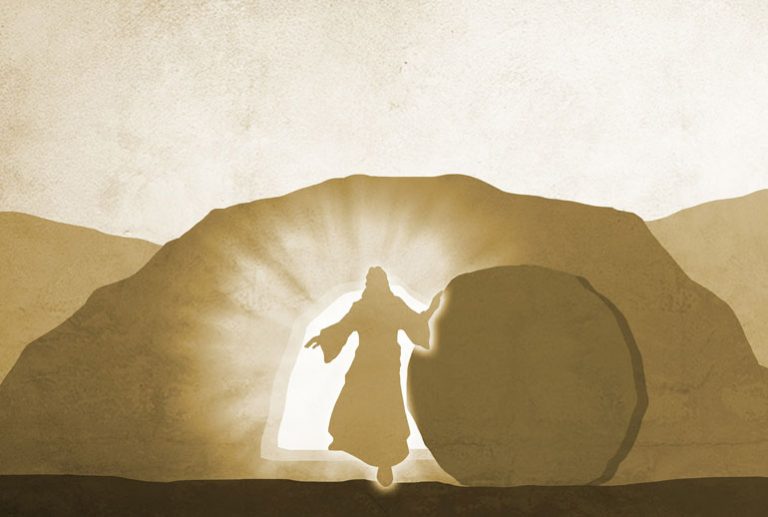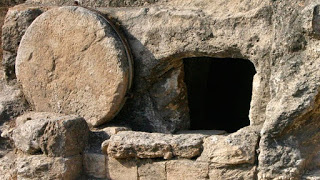The Gospel of Matthew records a key detail regarding the burial of Jesus: “So they went and secured the tomb by placing a seal on the stone and setting a guard.” (Matthew 27:66).
This detail is often overlooked, yet it is extremely significant. A casual reading may suggest that the word “seal” simply refers to the stone placed over the entrance to the tomb—which, of course, is true in a physical sense. However, that is not what the evangelist is emphasizing.
To understand this better, we can turn to a passage in the Book of the Prophet Daniel, which offers a historical precedent:
A stone was brought and placed over the mouth of the den. The king sealed it with his own signet ring and with those of his nobles, so that nothing could be altered with regard to Daniel. (Daniel 6:17)
In this context, the seal was a legal and official measure. It involved a rope or cord stretched across the stone that blocked the entrance. The ends of this cord were fastened to the rock wall using soft clay, and a seal was impressed into the clay using the signet ring of a Roman authority—in this case, Pontius Pilate, or someone acting under his authority.
The impression of the ring served as formal Roman authentication, making it clear that the tomb was under official watch. To move the stone, the seal would first have to be broken, which would constitute a direct violation of Roman authority.
Breaking such a seal was not a matter to be settled with the Sanhedrin or any local Jewish court. It was a serious offense against Rome itself—an act of defiance punishable by severe consequences.
This physical sealing technique remained in use until the late 17th century, when materials like sealing wax began to be employed to secure royal correspondence and other official documents. Typically red in color, sealing wax was made from a mixture of rosin, shellac, turpentine, and vermilion. Once a document was prepared, a small amount of this mixture was melted at the closure, and a government seal or the king’s signet ring was pressed into the wax and left to harden.
Once dry, the document could only be opened by breaking the seal—a deliberate act that would signal tampering. This method guaranteed privacy and protected the integrity of the message inside.
Why, then, did Governor Pilate go to such lengths to protect Jesus’ tomb with such official care?
To answer that, we must rewind the timeline by a few hours to the interrogation of Jesus before Pilate. According to the Gospel of John, during the trial, the crowd insisted that Jesus should be crucified because He had “claimed to be the Son of God”: “We have a law, and according to that law He ought to die, because He claimed to be the Son of God.” (John 19:7). Upon hearing this, the Roman governor became more afraid: “When Pilate heard what they said, he was even more afraid.” (John 19:8).
Like many Romans, Pilate was deeply superstitious. The possibility that Jesus possessed divine powers, or that He was a god or a descendant of the gods who had taken human form (cf. Acts 14:11), filled him with dread. If such were the case, then Pilate had just permitted the scourging and humiliation of a supernatural being—who might well seek revenge.
His fear was intensified by his wife’s dream, a troubling vision that prompted her to warn him: “Have nothing to do with that righteous man, for today I have suffered much in a dream because of him.” (Matthew 27:19). Driven by anxiety, Pilate questioned Jesus privately, asking: “Where do you come from?” (John 19:9).
Pilate was not inquiring about Jesus’ geographical origin, since he already knew He was a Galilean (cf. Luke 23:5–7). What Pilate sought to understand was Jesus’ nature. The question was prompted by what Jesus had previously told him: “My kingdom does not belong to this world.” (John 18:36).
Pilate wanted to know: Did this man belong to the realm of mortals, or was He from the realm of the gods?
But the few words Jesus offered in response did nothing to calm the governor’s fear. In the end, Pilate chose to appease the crowd, ordering the death of a man he still suspected might possess divine power. Better, he reasoned, to please the people than to risk a public uprising—especially during Passover, when Jerusalem was filled with pilgrims and religious fervor.
If Pilate had been deeply unsettled by Jesus’ words during the trial, that anxiety was nothing compared to what followed. The Synoptic Gospels recount an extraordinary event: “From noon until three o’clock in the afternoon, darkness came over the entire land.” (Matthew 27:45; Mark 15:33; Luke 23:44).
Was this darkness the result of a solar eclipse, as some have speculated?
The answer is no. A solar eclipse cannot account for darkness lasting more than three hours. In fact, according to astronomical calculations, the maximum duration of a total solar eclipse is just seven minutes and thirty-one seconds. Nevertheless, some Bible translations—such as The Book of God’s People[1]—refer to it as an eclipse.
Ancient historians, including Sextus Julius Africanus[2] and Tertullian[3], offered natural explanations such as a chamsin (a fierce sandstorm) or dense black clouds forewarning a severe storm. Regardless of the precise cause, the event only deepened Pilate’s superstitious fear. He must have longed for the day to end and to leave behind the disturbing chain of events unfolding before him.
Then, around three in the afternoon—the moment Jesus breathed His last—Pilate witnessed something even more terrifying: a powerful earthquake unlike anything he had ever experienced. “At that moment, the veil of the temple was torn in two from top to bottom, the earth shook, and rocks were split.” (Matthew 27:51; cf. Mark 15:38; Luke 23:45)
In that moment, the Roman governor had no doubts left. He realized he had not only condemned an innocent man, but someone extraordinary—someone backed by a supernatural force.
Sextus Julius Africanus also recorded the unusual natural phenomena surrounding the death of Jesus. In the third book of his Chronicle, a work composed of five volumes, he wrote:
A terrifying darkness fell over the whole universe; an earthquake broke the rocks; most [of the houses] of Judea and the rest of the land were razed to the ground. Thallus, in the third book of his Histories, regards this darkness as an eclipse of the sun, but without reason, it seems to me. [4]
In more recent times, geologists Jefferson B. Williams, Markus J. Schwab, and A. Brauer studied sediment disturbances in the Dead Sea region, near the shores of Galilee. Their research identified evidence of two major earthquakes: one significant quake around bc 31, and another, less intense but still notable, sometime between ad 26 and 36.
Their full study was published in Geology Review, Volume 54 (2012). While the authors were not entirely certain that the second quake could fully account for the tearing of the temple’s sanctuary veil, they acknowledged that the margins of error regarding both the magnitude and exact date could allow for that possibility.
Amid all these extraordinary events, Pilate’s concern intensified—particularly over the possibility that Jesus’ body might disappear, just as the Jewish leaders feared:
Sir, we recall that while He was still alive, that deceiver said, ‘After three days I will rise again.’ Therefore, command that the tomb be kept secure until the third day, lest his disciples come and steal him away and tell the people, ‘He has been raised from the dead.’ This last deception would be worse than the first. (Matthew 27:63–64)
In response, all available legal and security measures were employed to guard the tomb, ensuring that no one would dare to disturb the body during those long three days.
[1]“It was about noon, and darkness came over the whole land until three in the afternoon, because the sun was eclipsed. The veil of the temple was torn in two.” (Luke 23:44–45)
[2]Sextus Julius Africanus (c. ad 160 – c. 240) was a Christian historian and apologist of North African origin, influenced by Hellenistic culture. He is regarded as the father of Christian chronology for his efforts to systematically date biblical and historical events.
[3]Quintus Septimius Florens Tertullian (c. ad 160 – c. 220) was a Church Father and a prolific writer active during the latter half of the 2nd century and the early part of the 3rd century.
[4]Thallus was an early historian who wrote in Koine Greek a three-volume History of the Mediterranean World, covering events from before the Trojan War up to the 167th Olympiad.







